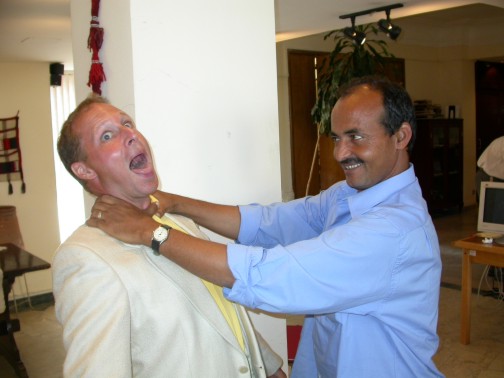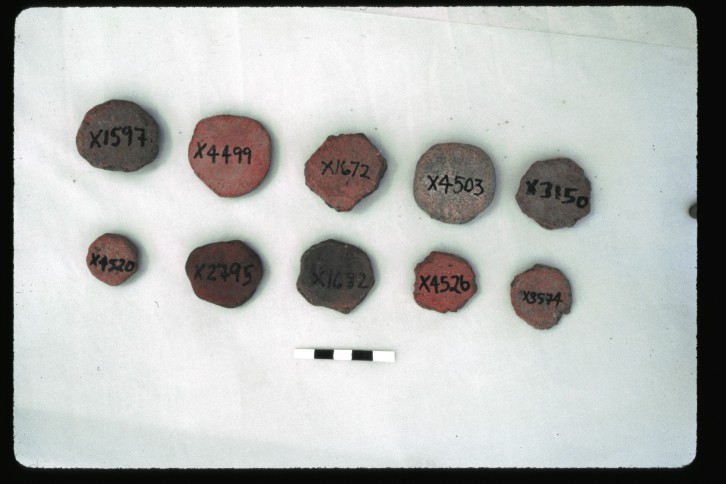Merry Christmas/Happy Holidays/Etc. to all ArchaeoBlog readers!
Yeah, so what am I doing blogging on Christmas Eve? I suck and have no life. Actually not, I have quite a few things to do today. No mad wrapping and/or last minute shopping though. My family is all back east so I get all the buying and shipping done shortly after Thanksgiving. BECAUSE I HATE STANDING IN LINES. I rather like the holidays, I really do. I didn't used to. Matter of fact, there were several Christmasses and Thanksgivings when I was a young green grad student that I spent it at the office or in the lab. About 10 years ago, I started to appreciate the season for whatever reason. Age maybe. I don't really
do much except listen to the music and do shopping for myself after buying stuff for everybody else, thus taking advantage of the sales. But I like strolling through the mall or downtown with all the decorations and Christmas items and people buying stuff. Some say it's become too commercial, but I think people really
like buying things for their friends and family. Yeah, we're supposed to show people we care all year round, but this is a time we can show it with a specific gift we've picked out for them. Probably something that's been going on ever since we came together in larger-than-family groups. I think people are friendlier around this time of year, too, despite the occasional madness around parking spaces.
Anyway, our one tradition is going to the zoo on Xmas eve. We started doing it a few years ago when we both had the day off and it was sunny and we didn't have anything else to do, so we went to the zoo. It's fabulous on Xmas eve because hardly anyone else is there, it's quiet, peaceful, and I think the critters are more active. Just a nice laid-back time without having to dodge strollers. And it's a nice break from all of the aforementioned madness. So we're doing that. I got the ArchaeoWife a new computer, a Dell Inspiron. I "gave" her my old computer a couple of years ago, but that one is kind of a pain, and she hates hates HATES the keyboard on this one. Plus, she uses MINE all the time.
I think I'm getting a new vacuum cleaner. Yes, I am weird about that. I have an old old tank of a Kirby that works very well, but it weighs a ton. I think it's an Electrolux cannister. I am indeed the Floor King at ArchaeoBlog Manor.
So, this morning I am doing a bit o' blogging and listening to Jimmy Buffett records (yes, records). A lot of people go through a Jimmy Buffett phase. Some never get out of it. I went through mine in my first couple of years of grad school when I did my field school out on San Juan Island, WA, living the whole island life while doing archaeology at the same time. Lots of drinking (I had a wet bar in my tent) and carousing and having a summertime fling with a perfectly delightful little blond. Perfect music for cruising the islands and mostly just having a good time and not worrying about money or a career yet. We worked hard, but had fun, too. Climb out of that filthy shell midden in the afternoon, drive to town and take a shower, come back for dinner (we had an excellent chef cooking for us), and then have martinis in and around our tents. Yeah, the grass behind those tents was pretty green and tall by the end of the summer, tellyawhat. On the weekends we'd mostly go drink at the
Downriggers in Friday Harbor where they made this
wicked cayenne pepper vodka martini. I also had a cast-iron stomach in those days.
Interestingly, there are various species of bioluminescent fauna in the waters around the islands. They bioluminesce when disturbed. This is particularly interesting for two reasons. First, if you happen to jump into Garrison Bay in the middle of the night, and especially if you're buck nekkid, it's like swimming in fireworks. Second, if you grab a bioluminsecent jellyfish and smoosh it all over your face, your face glows in the dark for a couple of minutes and then the next morning you wake up with decaying fish matter in your beard wondering what the heck you did last night and decide maybe you should swear off booze for a while but know good and well that that particular vow will only last until about 4:30 that afternoon so whatever.
Christ, I had a lot of fun back then. . . . .
Anyway, I hope you all have a happy and safe holiday. I really do appreciate your reading this humble blog every now and then.
UPDATE: I did, in fact, get a new vacuum, the Electrolux
Intensity.I admit it doesn't have the solidity of the old Kirby (the plastic handle feels kinda cheap and rickety) but it works very well and is WAY easier to maneuver around, let alone carry around the house. I'd been wanting a Dyson for a while, but those suckers start at like $450 and would probably be overkill for my uses. I have only two rooms with carpeting in them and I use a combination of a dustmop and a
Roomba to do most of that. So this one will fit the bill quite nicely.
I also got 4 seasons of The X-Files (</nerd>) and a
Grand Phone for my office. I have a 1950s desk that was owned by an engineer so this will look perfect. And a few other odds and ends. The ArchaeoWife loves her computer, and now it will give me the opportunity to reformat and rebuild the older one she was using. THAT should be a struggle; I tried once before to wipe the drive clean but it resisted all attempts to do so. Even after booting from a floppy the stupid thing still wouldn't let me reformat the hard drive. So, expect a post or two detailing my struggles there. Happily, you all will be spared the specific language I will no doubt direct Microsoft's way.












